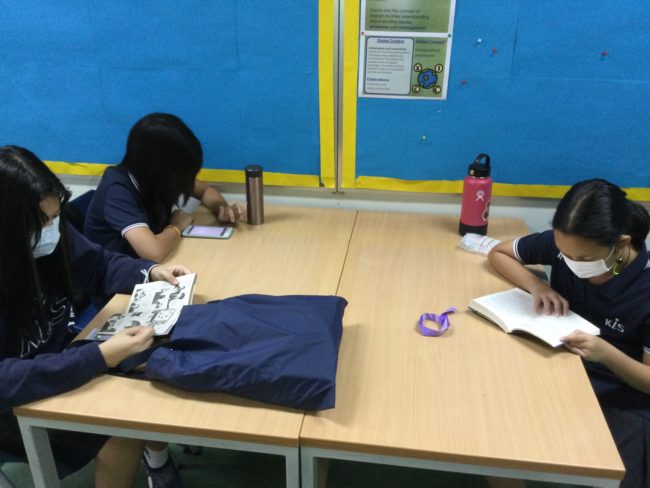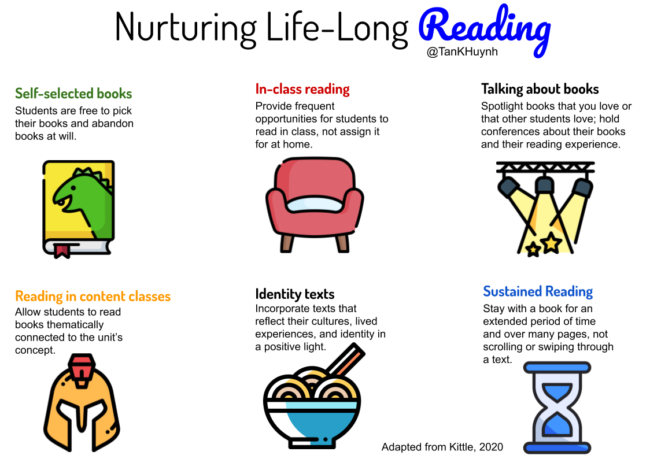In my practice, few things are more powerful than having students fall in love with reading. If I can get students to love reading, they will:
- Become better readers (Gallagher, 2009)
- Perform better on standardized assessments (The National Endowment for the Arts, 2004)
- Develop an extensive vocabulary (Wu & Samuels, 2004)
- Use more complex writing structures (Culham, 2011)
- Exercise greater emotional intelligence (Bishop, 1990)
You can also read this fascinating EdCan article that summarizes decades of research on the impact of reading. This article summarizes the key points celebrated author and English teacher Penny Kittle shared during her podcast interview on how teachers can nurture a reading culture. Our conversation was largely based on her ASCD article entitled “Let Them Read, Please” and her co-authored book with Kelly Gallagher, 180 Days.
Self-selected books
An unshakable love of reading is rooted in choice based on student interests (Ivey & Broaddus, 2001; Reis et al., 2007). Love of reading does not blossom, conversely, when students are forced to read books only at their reading levels. A reading life sprouts from student choice and withers without it.
Imagine, as adults, if you were never allowed to read Inside Out and Back Again, which won both a John Newbery Award and the National Book Award for Young People’s Literature, because it’s on a 3rd-5th grade reading level. Imagine you were only allowed to read dense academic journal articles because you now have advanced degrees. How engaged would you be as a reader in these cases?
For students to love reading, they must be allowed to read both difficult books and those that are below their level. It is our job to help them know when to abandon a book that doesn’t work for them and to teach specific strategies that raise comprehension.
In the picture below, three of my sixth graders are enjoying 5 minutes of free reading before class starts. One is reading a Thai ebook, another reading a comic in Thai, and the last reading a Thai chapter book. The platform, genre, and language ddoesn’t matter as much as students developing a love of reading.
In-class reading time
Reading mustn’t be assigned as an activity to do outside of class but an activity that everyone engages in during class time. Students’ lives will crowd out the time needed for sustained reading if students are assigned reading at home. In-class reading time helps students feel that they are part of a reading culture and communicates that reading is what people can do to enrich their lives.
Talking about books
A culture of reading occurs when people talk about books, characters, and their problems (Fall, Webb, & Chudowsky, 2000). Allow students to talk about books they liked with others. Make time for book clubs so that students can discuss the same book together.
Additionally, teachers can hold frequent book talks about books they’ve read to help students learn about different genres and develop an interest in reading as they experience the teacher’s enthusiasm (Gallagher & Kittle, 2018).
Finally, talking about books and reading can take the form of reading conferences. As students read, teachers can check in to do such things as:
- Teach a reading skill
- Identify if the book is a good fit
- Celebrate a reading achievement
- Build students’ capacity for greater comprehension
- Support students’ ability to form connections between ideas
Reading in content classes
A reading culture also forms when students are reading in classes outside of English. Students should be allowed to pick and read nonfiction and fiction books that are thematically connected to a unit in social studies or science. This develops a deeper understanding of the central concepts.
Teachers can also weave in short picture books as part of a text set. While these books may seem juvenile to older students, their concise, illustrated nature can further students’ grasp of a concept. They can quickly see how characters deal with the topic of study without being overwhelmed by too much academic language (Brooks, 2019).
In August of 2020, I assumed a secondary social studies teacher role. In all of my classes, the first thing my students do is read for five minutes from their self-chosen book. When I conference with them, I try to help them think about what the book can teach students about how individuals and communities behave.
Identity texts
Students will feel a greater desire to read when the books positively mirror their cultures, identities, and lived experiences. These books recognize their struggles, celebrate their gifts, and often offer approaches that language learners can adopt (Cummins & Early, 2011).
We need to expand our book offerings and include those that represent people from non-dominant cultures. In doing so, we communicate that all cultures are equally welcomed in our class and that we have much to gain from being part of a diverse community.
Additionally, allow students to read in their home language and from authors who come from their cultures. As long as students are seeing reading as an activity that adds to their life, then it does not matter the language they read in. In fact, literacy in one language is the foundation for language acquisition in another (Cummins, 2014).
References
Bishop, R. S. (1990). Mirrors, windows, and sliding glass doors. Perspectives, 6(3).
Brooks, M. D. (2019). Transforming Literacy Education for Long-Term English Learners: Recognizing brilliance in the undervalued. New York, NY: Routledge, Taylor & Francis Group.
Culham, R. (2011). Reading with a writer’s eye. In T. Rasinski’s Rebuilding the foundation: Effective reading instruction for 21st century literacy. Bloomington, IN: Solution Tree Press.
Cummins, J., & Early, M. (2011). Identity texts the collaborative creation of power in multilingual schools. Stoke on Trent: Trentham Books.
Cummins, J. (2014, November 14). Reversing Underachievement among Immigration-Background Students: what does the research say? Politeknik. http://politeknik.de/reversing-underachievement-among-immigrant-background-students-what-does-the-research-say-jim-cummins-the-university-of-toronto-2/
Fall, R., Webb, N. M., & Chudowsky, N. (2000). Group discussion and large-scale language arts assessment: Effects on students’ comprehension. American Educational Research Journal, 37(4), 911–941.
Gallagher, K. (2009). Readicide: How Schools Are Killing Reading and What You Can Do about It. Portland, Me.: Stenhouse.
Gallagher, K., & Kittle, P. (2018). 180 Days: two teachers and the quest to engage and empower adolescents. Portsmouth, NH: Heinemann.
Krashen, S. (2011). Free voluntary reading. Santa Barbara, CA: Libraries Unlimited.
National Endowment for the Arts (2004). Reading at Risk: A Survey of Literary Reading in America. Research Division Report 46. Washington, DC:Library of Congress.
Reis, S. M., McCoach, D. B., Coyne, M. Schreiber, F. J., Eckert, R. D., & Gubbins, E. J. (2007). Using planned enrichment strategies with direct instruction to improve reading fluency, comprehension, and attitude toward reading: An evidence-based study. Elementary School Journal, 108(1), 3–24.
Wu, Y., and Samuels, S.J. (2004). How the Amount of Time Spent on Independent Reading Affects Reading Achievement: A Response to the National Reading Panel. Paper presented at the International Reading Conference, Reno, NV, May 2–6, 2004.



